CASE STUDY
SUPERMARKETS
CASE STUDIES
SUPERMARKET SEES OVERALL ENERGY SAVINGS AND SOLUTIONS TO PROBLEMS OF SWEATING DOORS, HOT/COLD AREAS, SEVERE ENERGY LOSS, AND CUSTOMER SAFETY
The following is a complete case study of a 15,000 square-foot grocery store in Michigan. Air-Row Fans consulted with store managers to identify key problems in all areas of the store. Air-Row conducted its own analysis to determine the scope of the problems. Performance measurements on air distribution were taken before and after the installation of Air-Row Fans in key areas of the store to determine success.
PROBLEMS
Refrigerated Product Areas
Key concerns included the build-up of condensation and fog on windows, and water collecting on floors underneath the doors; requiring frequent mopping. Store managers were concerned for the safety of customers. Specifically, they feared wet floors could lead to a customer slipping, and that condensation build-up could lead to mold and potential health concerns.
Sales Check-Out Areas
These areas were warm and uncomfortable, as indicated by constant complaints from customers and employees. The continual opening of doors allowed in the heat and humidity, so even though the temperature in the rest of the store was comfortable, the check-out areas were not so.
Receiving & Stocking Areas
These areas have three (3) natural gas unit heaters and temperature sensors. All worked overtime heating and cooling these areas of the store.
SOLUTIONS
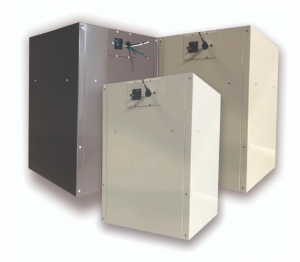
Air-Row installed F-18 destratification fans to meet solve these problems.
Supermarket Sees 24.3% Savings
Annual Cost of Heater Usage Without Air-Row Destratification Fans
Annual Cost of Heater Usage With Air-Row Destratification Fans
RESULTS
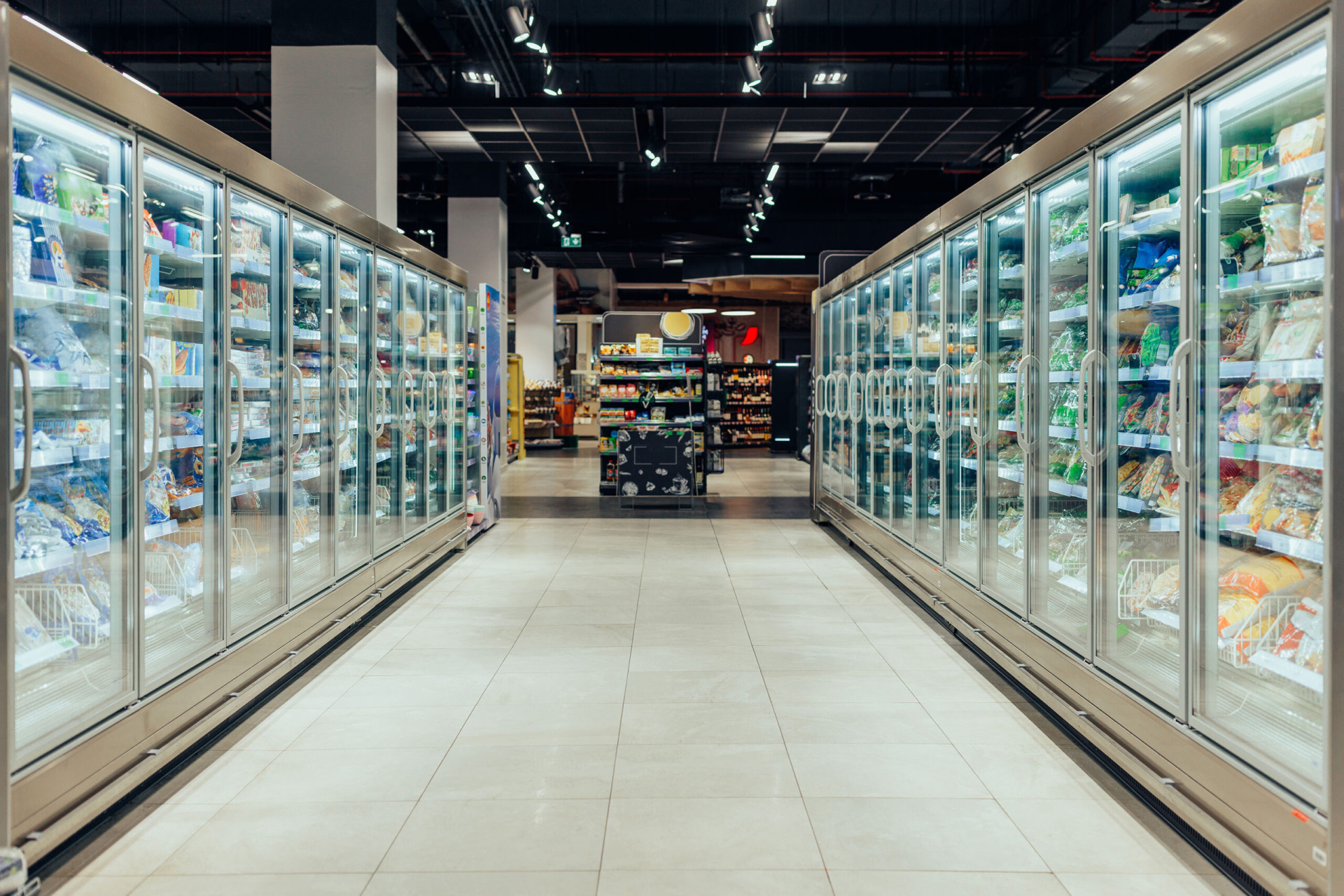
Refrigerated Product Areas
Cold air escapes from multi-deck and coffin freezers and lowers the ambient temperature in the store. This increases the load on the store’s heating system and causes a large temperature difference between the floor and the ceiling.
BTU/Ft Escaping from Freezers
| Temp | Multi-Deck | Coffin |
|---|---|---|
| Low | 990 | 255 |
| Medium | 760 | 175 |
| High | 610 | 140 |
Results
The addition of Air-Row fans in strategic areas throughout the store, particularly near the refrigerated cases, led to the elimination of fog and condensation on the refrigerated doors. Managers commented that product was much more visible and better displayed. Water no longer builds up under the cases, eliminating concerns for accidents and mold build-up.

Sales Check-Out Areas
The store entrance is a prime candidate for the installation of Air-Row fans. In the store vestibule, we mix and temper any outside air that enters before it reaches the check out and sales area.
Results
Fans added by Air-Row in the check-out areas were able to properly balance temperatures throughout the store while keeping temperatures the same. Air-Row was able to accomplish the temperature gains by using the air circulating in the store but rotating it and flowing it more adequately. Customers and employees both reacted positively to the changes.
Benefits
- Temper air entering the sales area
- Dry floors and shopping carts during inclement weather
- Maintain a tight floor to ceiling temperature (on average within 1-5°), which reduces the run time on the HVAC system.

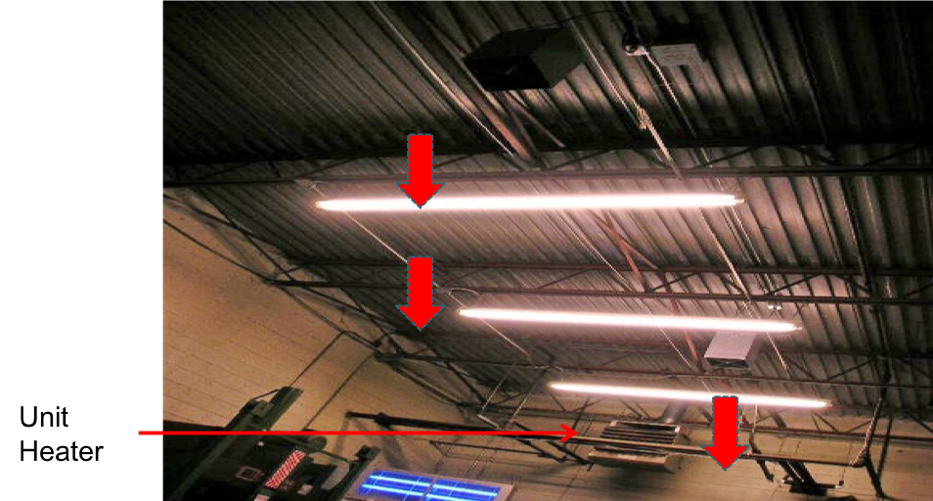
Receiving & Stocking Areas
The Receiving Area is a problem area for employee comfort and a MAJOR energy user! This area is usually heated by a natural gas unit or infrared heater. Both of these heaters create a disproportionate ceiling to floor temperature difference – often 30° to 60° Getting stratified heat to the floor reduces heat loss through the roof and out the top of receiving doors!
Stock and Storage Areas will often have 5 to 8 100,000 BTUH unit heaters trying to heat cluttered narrow areas. The super-heated air supply is directed at refrigerated cabinets which increase system loads. This combination creates a great opportunity for using Air-Row fans to facilitate significant Energy Savings!
Results in Receiving and Stocking Areas
These areas have three (3) natural gas unit heaters and temperature sensors. All worked overtime heating and cooling these areas of the store. Results — After installing Air-Row F-18 fans, there was a 40-50% reduction in burn time on all three units.
Benefits for Receiving Area
- Eliminate electric heaters at receiving desk
- Raise the floor temperature while reducing the ceiling to floor temperature difference
- Air-Row fans cut heater run time on average by 30 to 50%
- Major energy savings
- Comfortable work environment for employees
Benefits for Stock and Storage Areas
- Major energy savings with minimal investment
- Dry floors reduce accidents and odors
- HVAC unit life will be extended because of reduced run times and lowering heat exchanger operating temperatures
- Reduce the temperature on exterior walls of walk-in coolers and freezers
- Recommended storage area temperatures are 50° to 55°. Air-Row fan usage allows this temperature to be met with a thermostat setting of 55° to 60°
Impact of Air-Row Fans in Key Areas of the Supermarket
As a result of changes in all of these areas, thermostats in the store were reset 3-5 degrees lower and the Supermarket realized 9-15% energy savings. Employees and customers were extremely positive about the increased comfort of the store. The Air-Row fans now serve as the first step in the supermarket’s air distribution system. Large air handlers (heating and cooling) come on only when there is a need for thermal change. They cycle off as soon as this thermal change is satisfied.
| BEFORE AIR-ROW | AFTER AIR-ROW | ||||||
|---|---|---|---|---|---|---|---|
| Floor | Ceiling | Difference | Floor | Ceiling | Difference | ||
| Main Receiving Area | 50° | 85° | 35° | 56° | 73° | 16° | |
| East Receiving Area | 51° | 62° | 11° | 63° | 65° | 2° | |
| East Stock Room | 54° | 62° | 8° | 66° | 69° | 3° | |
| Stock Area at Sales Doors | 52° | 67° | 15° | 61° | 64° | 3° | |
| Stock by Hot Water Tanks | 58° | 78° | 20° | 67° | 74° | 7° | |
| Rear Deli Sales Area | 59° | 65° | 6° | 66° | 69° | 3° | |
| Glass Door Freezer Aisle #6 | 58° | 66° | 8° | 65° | 68° | 3° | |
| Glass Door Freezer Aisle #9 | 54° | 63° | 9° | 67° | 68° | 1° | |
| Check Out Exit Area | 60° | 66° | 6° | 66° | 67° | 1° | |
Destratify Your Air – Decrease Your Costs
Targeted Air Movement
- The Air-Row fans deliver a column of air from the top of the store down to the floor.
- The temperature difference in a store without destratification fans can vary by 15 degrees or more.
- Air-Row fans can reduce the temperature differential between the floor and ceiling to two degrees or less.
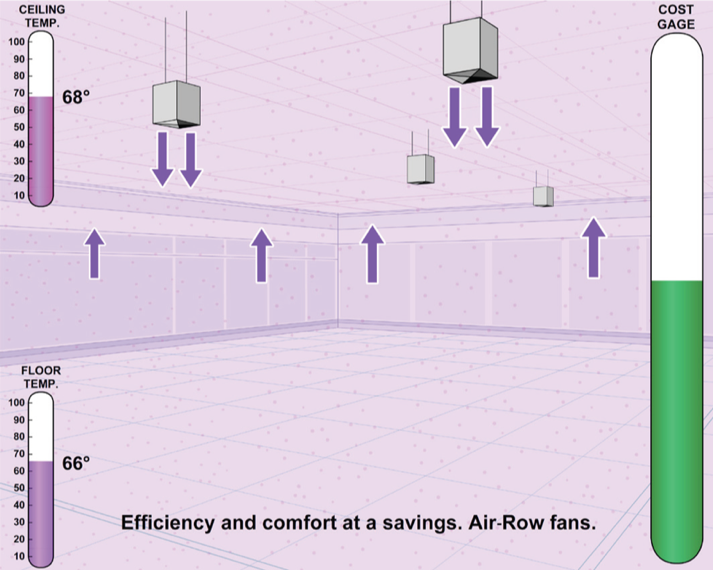
Benefits
- Customer and employee comfort is the principal reason for using Air-Row in this area
- Air-Row fans draw residual ceiling heat to an area that requires heat all year long
- Using residual ceiling heat and rotating overcooled air will reduce run time on adjacent HVAC units
- Reduce condensation on glass doors freezers
- Lower operating time for anti-condensate heaters if equipped with controls
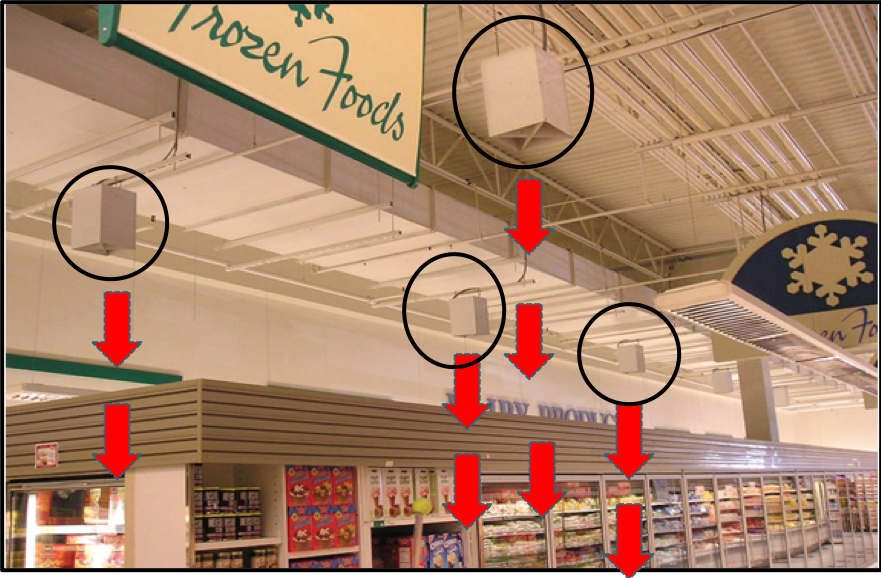
Minimize Heat Load
Notice that the average temperature in the lower half of the store has increased 3 degrees as a result of drawing heat from the ceiling and bringing it down to the floor. This is the area where the heat is required to provide comfort to the store occupants. The rise in temperature relieves the heating system from providing this heat.
Notice that the average temperature at the ceiling of the store has decreased by 5 degrees as a result of drawing heat from the ceiling and bringing it down to the floor. This means that less heat will escape from the ceiling of the store as the temperature difference between the ceiling inside the store and the outside air has decreased by 5 degrees. As less heat escapes from the ceiling, less heat has to be provided by the heating system.
Impact of Air-Row Fans
| Ceiling Height (ft) | Before Air-Row (℉) | After Air-Row(℉) |
|---|---|---|
| 20 | 73 | 68 |
| 15 | 70.5 | 67.5 |
| 10 | 67 | 67 |
| 5 | 63.5 | 66.5 |
| 0 | 60 | 66 |

